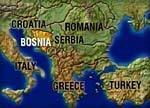SARAJEVO, Bosnia (November 24,2007) – Bosnia has now become one of the most advanced European countries related to the introduction of an independent and highly-sophisticated system of telecommunications owned by one or several state institutions. This was stated in the Bosnian capital Sarajevo by the Head of Delegation of the European Commission to Bosnia Dimitris Kourkoulas who attended the ceremony of introduction of the SDH (Synchronous Digital Hierarchy) network in Bosnia, which connects the Bosnian security and judiciary institutions and the Bosnian law implementing agencies.
Kourkoulas talked about the project which was financed by the EU in the amount of 3,1 million Euros.
”Implementation of this project was a challenge in technical, legal and political sense”, Ambassador Kourkoulas said and added that it is also a proof that there is political will present in Bosnia and that the country can face all the challenges of the 21st century.
The Bosnian Civil Affairs Minister Sredoje Novic talked about this system ownd by CIPS (Citizen Identification Protection System).The system enables a fast, reliable and efficient data exchange, as well as the exchange of images, pictures and sound. He said that once the SDH network is implemented in full capacity, 400.000 Bosnian Marks will be saved. That is the same amount of money used of the expenses of renting the links from the telecom operators.
He added that 2,3 million Bosnian have been ensured by the Budget through the CIPS direction, aimed to implement the project.
Head of the CIPS Project Implementation Direction Sinisa Macan talked about the technical characteristics of the network. He emphasized that precise rules and procedures for the users of the network are yet to be determined.
He said that it is the wireless communication structured on the basis of the radio relay system which can be advanced.
The network is a closed system outside the Internet. It functions in certain spectrum of frequencies designed for that purpose.
Saturday, November 24, 2007
Subscribe to:
Post Comments (Atom)







No comments:
Post a Comment